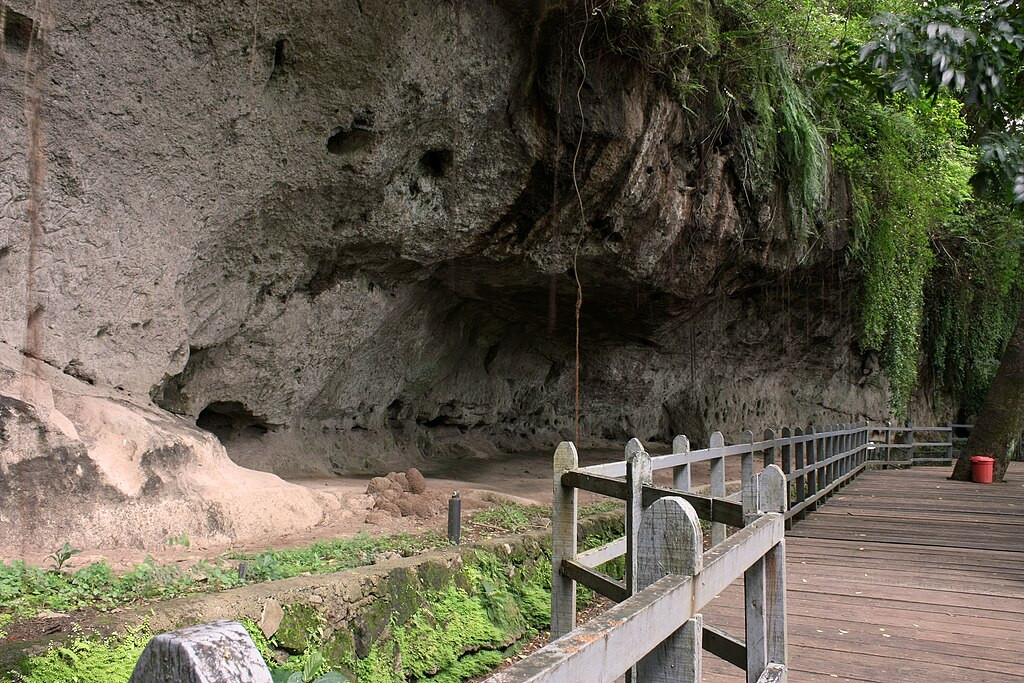- Finding Utopia Newsletter
- Posts
- Exploring the Abandoned Railways of the Philippines!
Exploring the Abandoned Railways of the Philippines!
Stories: Sabtang Island a Journey into the Soul of Batanes! - Echoes of the Past: Discover the Ancient Petroglyphs of Angono! - Experience the Spirit of March: Festivals Across the Philippines!

Hello Everyone,
Welcome to Finding Utopia, your go-to newsletter for discovering how to travel the Philippines and beyond!
Here is what we have for you today.
Exploring the Abandoned Railways of the Philippines!
Sabtang Island: A Journey into the Soul of Batanes!
Discover the Ancient Petroglyphs of Angono!
Experience the Spirit of March: Festivals Across the Philippines!
Exploring the Abandoned Railways of the Philippines!

Once a symbol of progress and national unity, the Philippine railway system once connected bustling cities, rural towns, and farmlands across Luzon. Today, many of its tracks lie silent and overgrown, remnants of a grand vision derailed by time.
In our latest blog post, we trace the rise and decline of the country’s once-thriving railway system, beginning with its historic first journey in the late 19th century.
It All Began in 1892
The Philippines' first railway line was inaugurated in 1892, stretching from Tutuban in Manila to Dagupan in Pangasinan. This 195-kilometer route marked a milestone in Philippine transportation, significantly reducing travel time across Central Luzon and fueling economic growth by connecting markets, farms, and ports.
Operated by the Manila-Dagupan Railway Company, this line would later become part of the Philippine National Railways (PNR)—a vast network that once reached as far as La Union in the north and Bicol in the south.
Ghost Stations and Forgotten Lines
Tutuban Station, the heart of the original railway, still stands in Manila—partly modernized, partly preserved as a silent witness to history.
Along the old Bicol Express route, abandoned bridges, rusting locomotives, and overgrown tracks reveal the legacy of a network that once pulsed with life.
Communities have reclaimed parts of the old lines, transforming former right-of-ways into footpaths, homes, and markets.
The Road to Revival
Recent years have brought a resurgence of hope. Projects like the North-South Commuter Railway and the planned Mindanao Railway aim to revive rail transport as a sustainable, affordable solution to traffic and inter-island connectivity. But rebuilding will take time, funding, and a firm commitment to long-term development.
Why It Matters
The abandoned railways remind us of a time when the Philippines imagined a more connected, mobile future. They stand as both a monument to national ambition and a lesson in the consequences of neglecting public infrastructure.
Read the full story:
Sabtang Island: A Journey into the Soul of Batanes!

Off the northernmost tip of the Philippines lies a remote island where time seems to stand still. Sabtang Island, part of the Batanes archipelago, is a living tapestry of Ivatan culture, rugged landscapes, and untouched beauty.
In our latest blog post, we take you on a journey to Sabtang, where traditional stone houses, windswept cliffs, and the quiet rhythm of island life reveal a side of the Philippines unlike any other.
Why Visit Sabtang Island?
Ivatan Heritage Preserved – The island is home to centuries-old stone houses built to withstand typhoons, offering a rare glimpse into the resilient and resourceful Ivatan way of life.
Stunning Coastal Views – From the dramatic Nakabuang Arch at Morong Beach to the rolling hills of Chavayan and Savidug villages, the island offers one breathtaking view after another.
Slow Travel, Rich Encounters – With no malls or chain hotels, Sabtang is best explored slowly—by bike, tricycle, or on foot—allowing you to connect with locals, landscapes, and living history.
Highlights of Sabtang
Morong Beach and Nakabuang Arch – A white sand beach framed by a natural stone arch, perfect for a quiet stroll or a quick swim.
Chavayan Village – The most remote village on the island, known for its well-preserved stone houses, narrow pathways, and scenic cliffside views.
Sabtang Lighthouse – A postcard-perfect site to catch the sunrise or sunset, with panoramic views of the sea and surrounding cliffs.
Ivatan Headgear (Vakul) – Learn about the iconic vakul, the handwoven headgear made from vuyavuy palm, worn by Ivatan women for sun and rain protection.
Plan Your Visit
Getting There: From Basco (Batan Island), take a 30-minute faluwa (traditional Ivatan boat) to Sabtang. Note: Trips are weather-dependent.
Best Time to Visit: March to May for calm seas and good weather.
Where to Stay: While most travelers visit as a day trip, homestays and guesthouses are available for those wanting to spend a night and experience the island’s quiet evenings.
Sabtang Island isn’t just a destination—it’s a window into a way of life shaped by isolation, community, and nature’s power. If you're looking for a meaningful and deeply immersive travel experience, this is it.
Read the full travel guide to Sabtang Island, Batanes here:
Start Speaking a New Language This Spring
Through award-winning lessons, innovative AI-driven conversations, and more engaging content, you can start speaking a new language in 3 weeks with Babbel—just in time for your next getaway. Plus, readers can get 55% off with this exclusive link.
Discover the Ancient Petroglyphs of Angono!

Long before the Philippines had written records, its early inhabitants were already telling stories—etched into stone. Just outside Metro Manila lies one of the most fascinating and oldest cultural landmarks in the country: the Angono-Binangonan Petroglyphs.
Discovered in 1965, this archaeological treasure offers a rare glimpse into the prehistoric lives, beliefs, and artistic expression of early Filipinos. In our latest blog post, we explore this remarkable site, its significance, and how it continues to inspire both historians and travelers alike.
What Are the Angono Petroglyphs?
Located in a rock shelter in Rizal Province, the petroglyphs consist of 127 human and animal figures carved into a volcanic rock wall.
These engravings are believed to date back to around 3000 BCE, making them the oldest known art in the Philippines.
The images likely served ritual or healing purposes, possibly connected to early animist beliefs and shamanistic traditions.
Why Visit This National Cultural Treasure?
A Rare Prehistoric Site – Few places in Southeast Asia offer such a well-preserved glimpse into early civilization.
Proximity to Metro Manila – Just a short drive from the capital, the site is an ideal day trip for history buffs, students, and families looking to experience something truly unique.
A Blend of Nature and History – Set in a serene, forested area near Thunderbird Resort and the Eastridge Golf Course, the petroglyph site offers a peaceful and educational escape.
Connected to Angono’s Artistic Legacy – Angono is known as the Art Capital of the Philippines, home to national artists like Carlos “Botong” Francisco, and this ancient site deepens that rich creative heritage.
Plan Your Visit
Getting There: From Manila, it’s a 1.5 to 2-hour drive to the site via Antipolo and Binangonan.
Entrance Fees: Minimal, with a small museum and pathway leading to the rock wall.
When to Go: Best visited in the early morning or late afternoon to avoid midday heat.
The Angono Petroglyphs aren’t just carvings—they’re conversations across millennia, reminders that art, culture, and belief have always been at the heart of the Filipino soul.
Read our full feature on the Ancient Petroglyphs of Angono here:
Experience the Spirit of March: Festivals Across the Philippines!

As March unfolds, the Philippines comes alive with vibrant festivals that reflect the nation’s rich history, cultural diversity, and deep spiritual roots. From solemn Holy Week processions to tribal gatherings in the mountains and celebrations of heroism and local bounty, there's a festival waiting for you to experience.
Here’s a look at the up-and-coming festivals this March, and why you should include them in your travel plans:
Moriones Festival - March 21–27 | Marinduque
Step into a dramatic reenactment of Roman times in this unique Holy Week tradition. The towns of Boac, Mogpog, and Gasan are transformed into open-air stages where mask-clad centurions reenact the story of Longinus, a Roman soldier converted by faith.
Allaw Ta Apo Sandawa - March 21–26 | Kidapawan City, North Cotabato
Join the indigenous tribes of Mindanao in honoring Mt. Apo, the country’s highest and most sacred peak. This annual cultural celebration features rituals, tribal music, dances, and sacred treks, offering visitors a glimpse into the spiritual life of the region’s highland communities.
Turumba Festival - March 21–26 | Pakil, Laguna
Celebrate one of the largest Marian devotion festivals in the country. The Turumba features seven processions commemorating the seven sorrows of the Virgin Mary, each held with music, dancing, and heartfelt community prayer.
Semana Santa in Dipolog and Silay City - March 21–27 | Dipolog and Silay
These cities mark Holy Week with powerful reenactments of the Passion of Christ. In Dipolog, witness spiritual rituals at St. James Church. In Silay City, experience a stylized theater performance, Good Friday processions, and artistic expressions of faith.
Alimango Festival - March 22 | Lala, Lanao del Norte
Celebrate the local harvest with fluvial parades, cultural contests, and creative presentations honoring the alimango (crab), a symbol of Lala’s abundant waters and proud fishing culture.
Birthday of General Emilio Aguinaldo - March 22 | Kawit, Cavite
Honor the legacy of the Philippines’ first President with a celebration at the Aguinaldo Shrine, featuring patriotic ceremonies and historical retrospectives on Philippine independence.
19 Martyrs of Aklan - March 23 | Kalibo, Aklan
A solemn tribute to the local heroes who fought against Spanish rule, this celebration blends cultural pride, history, and remembrance in one of the country’s most spirited provinces.
Malibay Cenaculo - March 24–25 | Pasay City
Experience a 10-day Biblical performance that dramatizes the passion of Christ, with live open-air performances in Pasay’s Malibay Plaza. A true blend of street theater, spirituality, and Filipino devotion.
Pasko sa Kasakit (Semana Santa sa Bantayan) - March 24 | Bantayan Island, Cebu
Known for its unique fusion of solemn rites and island hospitality, Holy Week on Bantayan Island offers both spiritual reflection and tropical relaxation. Walk the streets by day and relax on white sand beaches by evening.
Whether you’re searching for sacred traditions, cultural immersion, or natural beauty, these festivals are a meaningful way to experience the heart and soul of the Philippines.
Learn more about festivals and how to experience them in our upcoming features:





Reply